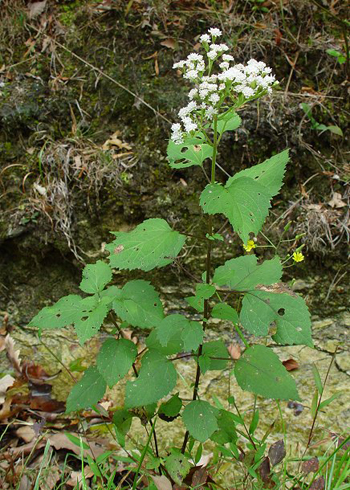Contents:
Common Names | Parts Usually Used | Plant(s) & Culture | Where Found
Uses | Warning | Bibliography
Scientific Names

- Eupatorium rugosum L.
- Composite family
Common Names
- White snakeroot
Parts Usually Used
Root, leaves
Back to Top
Description of Plant(s) and Culture
A variable perennial; 2-5 feet tall. Leaves opposite, on slender stalks; somewhat heart-shaped, toothed. Flowers are white, in branched clusters; blossoms in July to October.
Do not mistake white snakeroot for black cohosh (Cimicifuga racemosa) sometimes called black snakeroot. Senega snakeroot (Polygala senega L.) is of the milkwort family; black sanicle (Sanicula marilandica L.) is called snakeroot and is of the parsley family; Virginia snakeroot (Aristolochia serpentaria L.) is of the birthwort family. Each of these have the name snakeroot attached to them but they are not the white snakeroot reported on here (Eupatorium rugosum) of the composite family. Seneca and Virginia snakeroot are poisonous.
Back to Top
Where Found
Thickets. Quebec to Georgia; Texas to North Dakota.
Back to Top
Uses
Native Americans used root tea for ague, diarrhea, painful urination, fevers, “gravel” (kidney stones); poultice for snakebites. Smoke of the burning herb used to revive unconscious patients.
Back to Top
Warning
“Milk sickness”, with weakness and nausea, may result from consuming the milk of cows that have grazed on this plant. It is considered toxic. Do not use without medical supervision.
Back to Top
Bibliography
![]() Eastern/Central Medicinal Plants
Eastern/Central Medicinal Plants, by Steven Foster and James A. Duke., Houghton Mifflin Company, 215 Park Avenue South, New York, NY 10000
![]() American Folk Medicine
American Folk Medicine, by Clarence Meyer, Meyerbooks, publisher, PO Box 427, Glenwood, Illinois 60425, 1973
![]() The Complete Medicinal Herbal
The Complete Medicinal Herbal, by Penelope Ody, Dorling Kindersley, Inc, 232 Madison Avenue, New York, NY 10016, First American Edition, copyright 1993
![]() Webster’s New World Dictionary
Webster’s New World Dictionary, Third College Edition, Victoria Neufeldt, Editor in Chief, New World Dictionaries: A Division of Simon & Schuster, Inc., 15 Columbus Circle, New York, NY 10023
 How Indians Use Wild Plants for Food, Medicine & Crafts
How Indians Use Wild Plants for Food, Medicine & Crafts, by Frances Densmore, Dover Publications, Inc., 180 Varick Street, New York, NY 10014, first printed by the United States Government Printing Office, Washington, in 1928, this Dover edition 1974
 An Instant Guide to Medicinal Plants
An Instant Guide to Medicinal Plants, by Pamela Forey and Ruth Lindsay, Crescent Books (January 27, 1992).
 The Rodale Herb Book: How to Use, Grow, and Buy Nature’s Miracle Plants (An Organic gardening and farming book)
The Rodale Herb Book: How to Use, Grow, and Buy Nature’s Miracle Plants (An Organic gardening and farming book), edited by William H. Hylton, Rodale Press, Inc. Emmaus, PA, 18049., 1974
